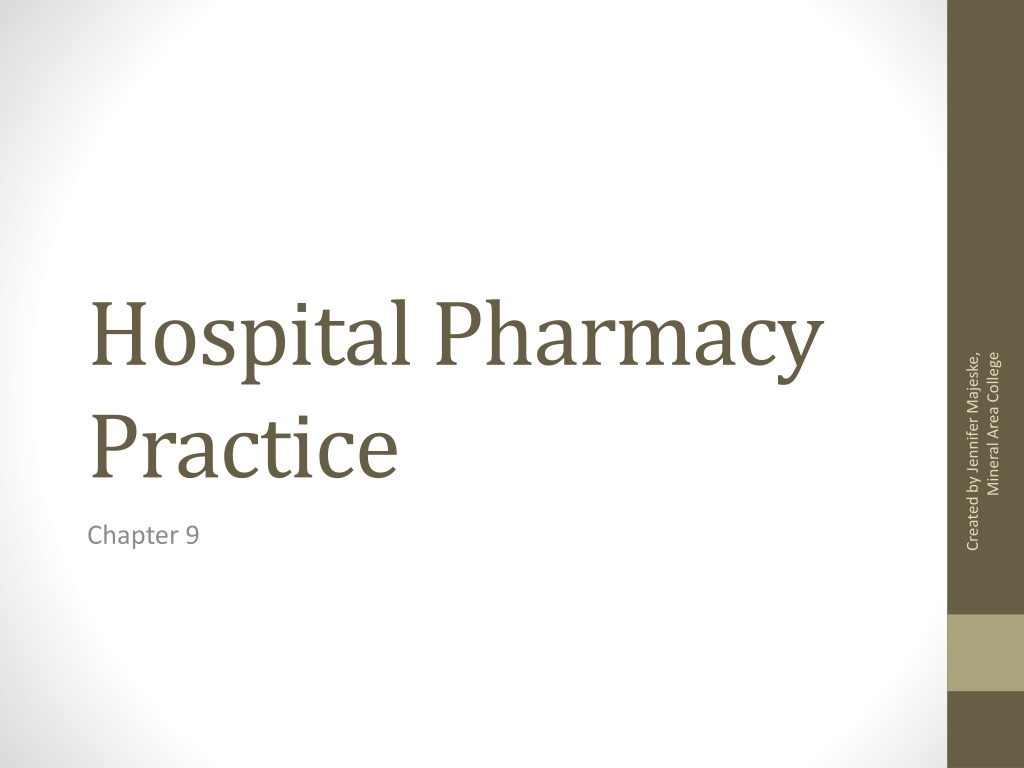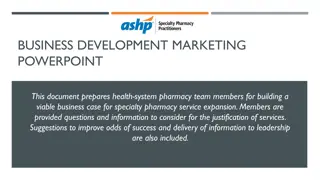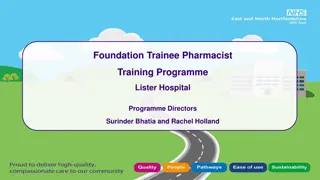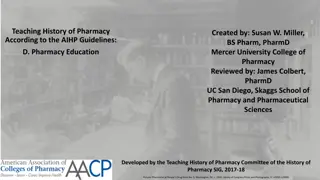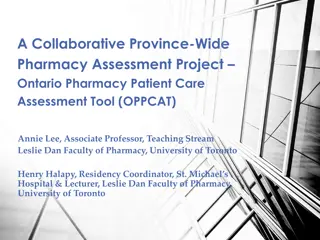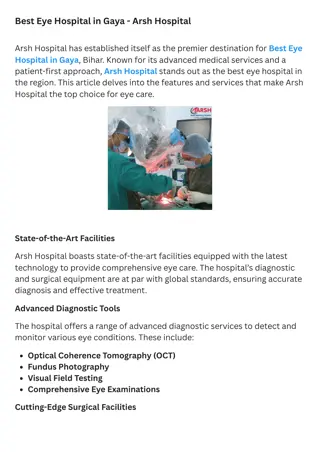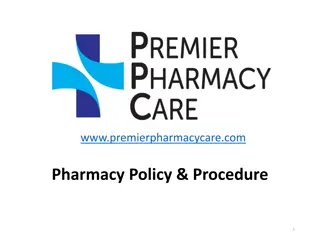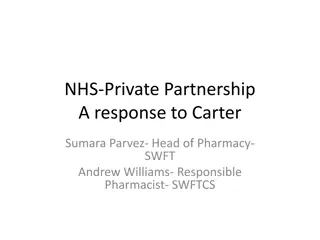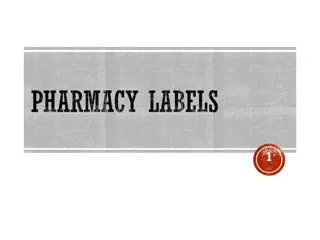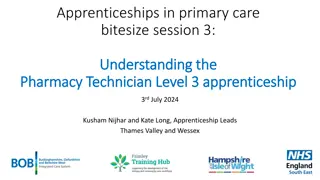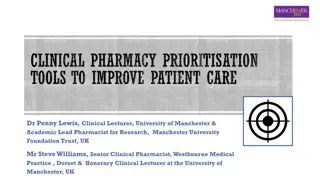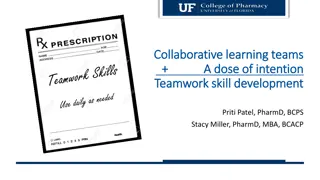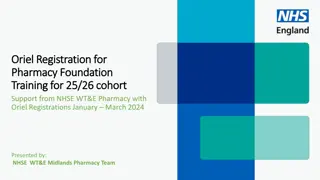Overview of Hospital Pharmacy Practice and Organization Structure
Hospital pharmacy practice encompasses various functions, including medication dispensing, inventory management, and specialized services like IV admixtures. The organizational structure involves committees, such as Pharmacy and Therapeutics, and key roles like the director of pharmacy. Automation plays a crucial role in medication processes, and pharmacy technicians are required to be certified for hospital settings. Hospitals are classified based on bed capacity, services provided, and ownership, with the overall framework overseen by a CEO and board of directors.
Download Presentation

Please find below an Image/Link to download the presentation.
The content on the website is provided AS IS for your information and personal use only. It may not be sold, licensed, or shared on other websites without obtaining consent from the author. Download presentation by click this link. If you encounter any issues during the download, it is possible that the publisher has removed the file from their server.
E N D
Presentation Transcript
Hospital Pharmacy Practice Created by Jennifer Majeske, Mineral Area College Chapter 9
Learning Objectives Describe the classifications and functions of a hospital and the role of the director of pharmacy. Identify the roles of major hospital committees that impact pharmacy. Describe the role of the Institutional Review Board in approving investigational drug studies. Explain the functions of a hospital pharmacy department. Describe the roles and responsibilities of the director of pharmacy, pharmacist, and pharmacy technician in a hospital pharmacy. Describe the types of medication orders and the order entry system. Created by Jennifer Majeske, Mineral Area College
Learning Objectives Understand the unit dose dispensing system and the unit dose cart used in hospital pharmacy practice. Identify the advantages and disadvantages of a unit dose vs. a robotic drug distribution system. Explain the proper procedure for preparing, labeling, and repackaging of medications. Identify the process of medication filling and dispensing in a hospital pharmacy. Describe specialty services, such as intravenous admixtures and total parenteral nutrition. Discuss the advantages of an automated floor stock system for medication, including narcotics. Created by Jennifer Majeske, Mineral Area College
Learning Objectives Describe the purpose and advantages of an electronic medication administration record. Discuss the role of automation and inventory control in the hospital. Understand inventory management of pharmaceuticals, including drug-bidding, ordering, receiving, and storage processes. Explain the major role of the Joint Commission in establishing accreditation standards for hospitals. Created by Jennifer Majeske, Mineral Area College
Introduction Hospital pharmacy practice is unique in organizational structure, tasks and responsibilities. Pharmacy technicians MUST BE CERTIFIED to work in a hospital setting and have specialized training in oral and parenteral medications, unit dose medications, repackaging, floor stock, narcotic inventory, IV admixtures, and chemotherapy. Automation is depended on, even more than in a community pharmacy, for medication ordering, filling, distribution, and bedside drug administration. Technicians need to be familiar with these advancing technologies. Created by Jennifer Majeske, Mineral Area College
Hospital Functions and Organization Hospitals provide needed emergency, trauma, surgical, and medical services to a community. Hospitals can be classified by: Bed capacity, patient populations, type of service, affiliation, ownership, length of stay, financial status Organizational Framework: A president, or CEO (chief executive officer), runs the hospital and reports to a board of directors. Vice presidents preside over various departments. Hospital Committee Structure: Pharmacy and Therapeutics (P&T) Committee Institutional Review Board (IRB) Infection Control Committee Created by Jennifer Majeske, Mineral Area College
Pharmacy and Therapeutics Committee Pharmacy and Therapeutics (P&T) Committee meets to review medication guidelines and issues pertinent to patient care. Composed of medical staff, hospital and nursing administration, the director of pharmacy and a drug information pharmacist. Drug Formulary an accepted list of approved drugs used in that hospital. New drugs considered by the P&T Committee must be submitted with an extensive medication application form. Medication Error Reports are reviewed by the P&T Committee. The focus is not to place blame, but to identify and correct the system s problem so the error does not recur. Created by Jennifer Majeske, Mineral Area College
Pharmacy and Therapeutics Committee Institutional Review Board (IRB) the Human Use Committee reviews the use of investigational drugs or procedures in the hospital setting and to provide appropriate safeguards for its patient population. Investigational drug a drug that is being used in clinical trials and has not yet been approved by the FDA in the general population. Clinical Research Investigational Study requires approval from the IRB before beginning. Informed consent a document written about the study in terms that are understandable to laypersons. The IRB protects the patient by ensuring adequate knowledge of the risks of the study and confidentiality of medical confidentiality. Created by Jennifer Majeske, Mineral Area College
Hospital Pharmacy Department Occupies a centralized location that is readily accessible to the ER and elevators to patient care units and surgical suites. Layout includes unit dose cart filling, repackaging, narcotic and investigational drug storage, and preparation of sterile products. Specialized Services: Staffed 24 hours a day, 7 days a week Medication preparation and delivery IV additive programs Investigational drug storage and control Drug information center Less chaotic Minimal interaction with the public No prescription insurance issues Created by Jennifer Majeske, Mineral Area College
Hospital Pharmacy Personnel Hospital pharmacy staff is typically composed of: A director of pharmacy Additional associate or assistant directors of pharmacy (larger hospitals) Pharmacists Pharmacy technicians A large hospital usually staffs 10 or more pharmacists & technicians per day shift. Larger hospitals may have pharmacy interns (pre-graduate) and residents (post-graduate). The overall responsibilities of the hospital pharmacy personnel, no matter the size, remain the same. Created by Jennifer Majeske, Mineral Area College
Director of Pharmacy Director of Pharmacy the pharmacist in charge who oversees the day-to-day operations of the hospital pharmacy department. Key Responsibilities: hiring, budget, evaluating, and firing; developing strategies; complying with federal and state regulations and laws; and establishing policies and procedures. Determining Pharmacy Services: the director determines the level and scope of pharmacy services, including: Types of medication distribution systems Service availability Source of inventory Protocol Instruction Specialty services Created by Jennifer Majeske, Mineral Area College
Director of Pharmacy Planning and Monitoring the Budget: the director of pharmacy is responsible for submitting and monitoring an approved budget. Drug budgets can be hard to predict; budgetary impacts of new drugs and hospital services must continually be assessed. Budgetary restrictions can result in the outsourcing of distribution or clinical services. Staffing is also affected by the budget; staffing needs are based on projected census (hospital bed occupancy) as well as hours of operation and scope of services. Developing the Policy & Procedure (P&P) Manual a written, step-by-step set of instructions on all operations within the pharmacy. Created by Jennifer Majeske, Mineral Area College
Hospital Pharmacist Pharmacists who work in a hospital setting share a lot of the responsibilities and functions of their community pharmacist counterparts. Consult with physician, interns, residents and nurses. Up-to-date on drugs moving in and out of the market. Skills necessary to compound sterile products and prepare emergency medications needed in a code blue. Major Responsibilities: entering medication orders, assisting in cart fills, ordering, providing drug information, assisting in CPR codes, investigating medication errors, and representing the pharmacy department on hospital committees. Created by Jennifer Majeske, Mineral Area College
Hospital Pharmacy Technician Technician s role in the hospital setting is expanding, playing a key role in preparing and delivering the right drug at the right dose by the right route to the right patient at the right time. Key Responsibilities: technicians are trained to perform all major functions within the pharmacy. Filling the Unit Dose Cart: filling the unit dose cart is a responsibility of the technician; dispensing enough medication for 12 72 hours. Stocking the Medication Dispensing Units: restocking automated dispensing units; checking for expired drugs. Preparing IV Admixtures: aseptic preparation of parenteral products is a major difference from community pharmacy practice, in terms of pharmacy technician involvement; compliance with specific USP Chapter <797> standards. Created by Jennifer Majeske, Mineral Area College
Hospital Pharmacy Technician Monitoring Inventory and Narcotic Control: inventory control; ordering, receiving, and proper storage. Filling the Crash Cart a mobile cart that holds necessary drugs for an emergency code such as a Code Blue. The cart may be kept in the pharmacy, on a nursing unit, or in the emergency department. Training and Certification: Highly trained Learning curve, 3 months or longer Specialization Must be certified! Additional certification may be required Created by Jennifer Majeske, Mineral Area College
Inventory Management Up to 70% of a hospital pharmacies budget is spent on pharmaceuticals. Budget planning and accurate inventory tracking are extremely important, and are often responsibilities of a senior technician. This person assumes the role of buyer and is responsible for preparing contracts, bids, ordering and receiving. Automation assists the pharmacy in meeting and adjusting budgetary goals. Space is limited, so it is important to have sufficient inventory without shortages. Physical inventories are typically performed annually. Created by Jennifer Majeske, Mineral Area College
Bidding and Purchasing of Pharmaceuticals Patients need to receive the highest quality pharmaceuticals at the lowest costs. Drug-Bidding Process: involves collecting information necessary for the bidding process; a competitive process; most bids locked in for one year. Ordering of Pharmaceuticals: most hospital pharmacies order from a prime vendor wholesaler. Nonformulary Drugs: a patient may be charged for the bulk purchase of a nonformulary medication. Drugs Borrowed from Other Facilities: a hospital pharmacy may have the need to borrow medications from another hospital or community pharmacy; documentation is crucial when borrowing medications, especially controlled substances. Created by Jennifer Majeske, Mineral Area College
Receiving and Storage of Drug Inventory Once an order is received, it must be checked against the invoice. Any discrepancies must be resolved; the order should be checked for completeness as well as any potentially damaged goods. Special Handling of Certain Pharmaceuticals: special consideration is necessary for controlled substances & investigational drugs. Controlled Substances: the Controlled Substance Act defines ordering, inventory, filing, and record-keeping requirements for controlled substances. Scheduled II must be authorized by the pharmacist; physical inventory must be completed every 2 years, per DEA. Investigational Drugs: all investigational drug studies must be approved by IRB; these drugs must be maintained in a secure and separate area of the pharmacy. Created by Jennifer Majeske, Mineral Area College
Performing Daily Inventory Responsibilities All technicians must assist in receiving and storing ordered items from the wholesaler; store under proper conditions; monitor out-of-stocks. Rotating Inventory: stock must be rotated so that the most recent inventory is not used first; inventory turnover is rapid and expired drugs are rarely found. Processing the Returned Unit Dose Cart: patient drawers are checked by the technician and emptied when a unit dose cart is returned to the pharmacy; missed doses need to be investigated. Restocking Automated Equipment: perpetual inventory; feed the robot ; automated systems optimize inventory control by minimizing costs and out-of-stock items. Created by Jennifer Majeske, Mineral Area College
Performing Daily Inventory Responsibilities Transporting and Tracking of Narcotics: technicians are often responsible for transporting narcotics to the nursing unit; documentation is often required upon exchange of narcotics from the technician to the nurse; an unusual increase in controlled substances should be reported by the technician. Checking for Drug Recalls: technicians are responsible for retrieving of any medications that are subject to FDA or drug manufacturer recall; the technician should compare lot number of the drug in the recall notice with the inventory; the drug is then returned to the wholesaler (or manufacturer) for credit. Schedule II returns are rare and require the special DEA 106 form to be completed by the pharmacist. Created by Jennifer Majeske, Mineral Area College
Hospital Medication Orders and Order Entry Hospital pharmacies typically receive a medication order via an electronic transmission; the medication order however may be delivered via personal delivery, fax, phone order, of pneumatic tube system. Medication Order a prescription that arrives in a hospital pharmacy. Medical chart record, a legal document that contains all the patient s demographics and room number as well as all orders written by medical staff. Types of Medication Orders: admitting order, stat order, daily or continuation order, standing order, and discharge order. Admitting Order written by the physician upon patient admission to a hospital. What can be included on an admitting order? Created by Jennifer Majeske, Mineral Area College
Hospital Medication Orders and Order Entry Stat Order an emergency order that is typically called in or sent electronically to the pharmacy; this must receive priority attention. Daily and Continuation Orders: daily order a new medication order written daily by a physician after every patient examination. Continuation order review, approve, and rewrite all daily medication orders at least weekly. Standing Order a medication order in which the same set of medications and treatments applies for each patient who receives a similar treatment or surgery. Discharger Order an order that provides take-home instructions for a patient who is being discharged from the hospital. Created by Jennifer Majeske, Mineral Area College
Inputting of Hospital Medication Orders Pharmacies may receive medication orders written by a physician or transmitted via computerized prescriber instructions. What might be included on a hospital medication order? Computerized Prescriber Order Entry: the use of automation and electronic health records (EHRs) are becoming increasingly commonplace in hospitals. Computerized prescriber order entry (CPOE) electronic entry of prescriber instructions; patient management software. What are some benefits of using CPOE software? Pharmacy Department and CPOE: what benefits are there in the pharmacy using CPOE software? Created by Jennifer Majeske, Mineral Area College
Hospital Pharmacy Inpatient Drug Distribution Systems Inpatient drug distribution system dispenses medications to patients; 12-72 hour supply of individually packaged medications is sent to each patient care unit. Unit Dose Dispensing System an amount of a drug prepackaged for a single administration; important part of the inpatient drug distribution system, and its use streamlines the medication distribution process. Unit Dose Formulations: what information is included on a unit dose label? Unit Dose Cart a movable cart that contains removable cassette drawers that house medications; cassette drawers are labeled with a specific patient s name and room number; medications are generally provided for 24 hours. Created by Jennifer Majeske, Mineral Area College
Hospital Pharmacy Inpatient Drug Distribution Systems Benefits of the Unit Dose System: offers benefits to patients, healthcare personnel and the hospital. Streamlined Work Flow Process: nurses on patient care units can simply administer the medication to the patient rather than preparing the dose from multi-dose containers. Decreased Medication Errors: bar codes placed on the unit dose medications offer an additional safety check before administration. Increased Medication Safety: all necessary medications are kept in a specific cassette drawer. Reduced Medication Waste: unused medications can be returned to inventory. Increased Cost-Effectiveness: easier method for billing. Patient Costs of the Unit Dose System: proportionately higher than one dose from a retail pharmacy. Created by Jennifer Majeske, Mineral Area College
Repackaging Medications into Unit Doses Pharmacy technicians may need to repackage medications. Medication special a single dose preparation made for a particular patient. Manual unit dose packaging include: ziplock bags, adhesive- sealed bottles, blister packs, and heat-sealed packages. Labeling and Documentation of Repackaged Medications: repackaged medications must be labeled carefully. Repackaging control log repackaging documentation, Figure 9.2 pg. 377. Additional information may be required for repackaged drugs depending on hospital policy, state guidelines, and accreditation standards. Created by Jennifer Majeske, Mineral Area College
Processing Medication Orders Using the Unit Dose System Medication orders received by the hospital pharmacy entered into the pharmacy database are filled on a regular basis until the patient is discharged from the hospital. Using a Cart Fill List: unit dose label created after a medication order is entered in the computer database, includes the name of the patient; name and strength of the medication; the frequency, route and time of administration; and bar code. Patient profiles documentation that provides the information necessary to prepare the unit dose. Cart fill list list of doses to be prepared and sent to the patient care unit. Created by Jennifer Majeske, Mineral Area College
Processing Medication Orders Using the Unit Dose System Filling Unit Dose Orders: pick station an area of the inpatient pharmacy with frequently prescribed formulary drugs in commercially available unit dose packaging. Robotic Dispensing System: centralized automated robotic dispensing system to fill unit dose orders; integrated with hospital software and stores more than 1,000 of the most frequently prescribed drugs. Operation of the Robot: using bar-code technology, the robot can pick, count, package, store, and dispense medications; some robots have the ability to assist in compounding. Bar-code point-of-care (BCPOC) bar-code technology used at the patient s bedside. Created by Jennifer Majeske, Mineral Area College
Benefits of the Robotic Dispensing System Decreased Medication Errors: medication errors represent 21% of all medical errors in the hospital, and are responsible for the deaths of 7,000 patients annually. Combined use of robotic technologies, and CPOEs has resulted in an accuracy rate near 100%. Reduced Pharmacy Workload: reduces pharmacists workload by 90% and pharmacy technician workload by 72%; allowing pharmacists to provide more patient care. Increased Long-Term Cost Savings: short-term costs associated with the robotic dispensing system ($1 million) is offset by the long-term cost savings. Created by Jennifer Majeske, Mineral Area College
Intravenous Admixture Service Intravenous (IV) admixture service this service is responsible for the safe and accurate preparation of many parenteral medications. Preparation of Parenteral Medications: pharmacy personnel must typically reconstitute medications in sterile water or NS; these medications are then administered to patients by IV infusion. Parenteral medications are prepared by specially trained individuals in a sterile, germ-free clean room, using USP Chapter <797> aseptic protocol. Medications are prepared in a horizontal laminar airflow hood. Protective clothing and a specialized hood are used in the preparation of caustic medications. Created by Jennifer Majeske, Mineral Area College
Total Parenteral Nutrition Service Total parenteral nutrition (TPN): a specially formulated IV solution that provides for the entire nutritional needs of a patient who cannot or will not eat. Technicians must be certified and complete additional training for the preparation of TPN s. Preparation of TPN: provides for the entire nutritional needs of a patient who cannot or will not eat. Administered directly into the patient s vein (central line) TPN solution may contain more than 20 ingredients. Larger hospitals use automated compounding device (ACP) to make multiple TPN solutions. Smaller hospitals may outsource their TPN preparations. Off-site pharmacies must meet all state and federal laws and regulations. Created by Jennifer Majeske, Mineral Area College
Nursing Unit Drug Administration and Documentation Medications can be obtained through a secure floor stock delivery system, aside from the hospital pharmacy. Floor Stock an inventory of frequently prescribed drugs that is stored on the patient care unit rather than delivered by a unit dose cart. Floor Stock and Automated Medication Dispensing Systems (AMDS) AcuDose-Rx, Pyxis; floor stock now consists of frequently used medications, controlled substances, and IV fluids that meet the needs of a particular care unit. Benefits of Floor Stock AMDS: an extension of the unit dose delivery system and offers advantages for the patient, healthcare professional and hospital. Created by Jennifer Majeske, Mineral Area College
Nursing Unit Drug Administration and Documentation Decreased Medication Errors: the use of AMDS reduces the incidence of medication errors; example 93% reduction in medication errors at Beloit Memorial Hospital in Beloit, Wisconsin. Secure Medication Storage: drawers can be set with a variety of security levels; varying levels of access for hospital personnel; security and accountability. Streamlined Work Flow: nursing personnel can administer medications in a more timely manner; fewer telephone calls and interruptions to the pharmacy. Improved Tracking of Medications: an AMDS documents each step of the medication dispensing and administering process; tracks medications by type of drug, dose, patient, and caregiver. Created by Jennifer Majeske, Mineral Area College
Narcotics Commonly kept on the floor unit, varying with type and quantity. An audit trail must exist to account for controlled substances; date and time of narcotic administration must be verified with the medication order, nurse administration record, and a Schedule II drug administration record. Figure 9.6 pg. 385 Schedule II Drug Administration Form Narcotic and Automated Inventory Systems: provide additional security and tracking; allows for separate reporting for Schedule II, III, and IV drugs; provides real-time reports and immediate access to information in regards to narcotic usage on a particular unit. Created by Jennifer Majeske, Mineral Area College
Medication Administration Record Medication administration record (MAR) record of the administration of any medication to the patient. Electronic medication administration record (eMAR) legibly documents the administration time of each drug to each patient using a bar-code technology at the patient s bedside. eMAR Process: patients are given a bar-coded wristband to wear that confirms their identity and the prescribed medications; medication orders are inputted by the physician at the patient s bedside; the order is electronically transmitted to the pharmacy. Benefits of eMARs: what benefits exist with eMARs? Created by Jennifer Majeske, Mineral Area College
Hospital Accreditation Accreditation by the Joint Commission achieves reimbursement from Medicare, Medicaid, and private insurances. Joint Commission an independent, not-for-profit organization that sets and measures the standards for quality and safety of health care through an accreditation process. The Joint Commission accredits more than 19,000 hospitals, home healthcare systems, and long-term care facilities. http://www.jointcommission.org/ Accreditation is like the Good Housekeeping seal of approval; it means the hospital has met specific standards for both quality and safety. Hospitals are evaluated on performance in specific areas, compares those against defined standards, and awards a hospital accreditation status if the hospital meets or exceeds those standards. Created by Jennifer Majeske, Mineral Area College
Conducting an On-Site Survey Inspection of a hospital for pending accreditation is sometimes referred to as a survey. This is an extensive, multiday, on-site visit. The survey team comes unannounced, random visit to conduct an evaluation. Hospital performance is evaluated by the survey team, the P&P manual is reviewed and hospital personnel may be interviewed. In addition to Joint Commission standards, the hospital must abide by all state and federal laws and regulations. Reimbursement by Medicare, Medicaid and private insurance requires Joint Commission accreditation. Created by Jennifer Majeske, Mineral Area College
Setting Quality of Care Standards The National Quality Improvement Goals provide standards for quality of patient care in select patient populations. A survey team requests medical charts to randomly view for compliance. With heart attack patients, as the example in your text states, what sort of things is the Joint Commission looking at (pg. 388-389)? Performance is compared to other hospitals of similar size that are accredited. Comparative analysis is performed at the state and nationwide level and is made available to employers and patients. Created by Jennifer Majeske, Mineral Area College
Establishing Safety-Related Standards Approximately 50% of the Joint Commission standards are directly related to safety. Safety-related standards include: Reconciling a patient s medication profile Improving safety of medication use Drug infusion pumps Reducing hospital acquired infections Medicare no longer reimburses hospitals for additional cost of treating preventable medication errors, injuries and infections. Medicare no longer reimburses for preventable hospital readmissions within 30 days. Created by Jennifer Majeske, Mineral Area College
This workforce solution was funded by a grant awarded by the U.S. Department of Labor s Employment and Training Administration. The solution was created by the grantee and does not necessarily reflect the official position of the U.S. Department of Labor. The Department of Labor makes not guarantees, warranties, or assurances of any kind, express or implied, with respect to such information, including any information on linked sites and including, but not limited to, accuracy of the information or tis completeness, timeliness, usefulness, adequacy, continued availability, or ownership. Created by Jennifer Majeske, Mineral Area College This work by Mineral Area College is licensed under the Creative Commons Attribution 4.0 International License.
